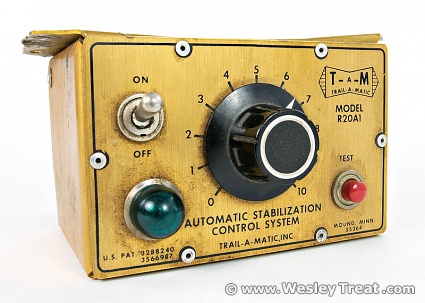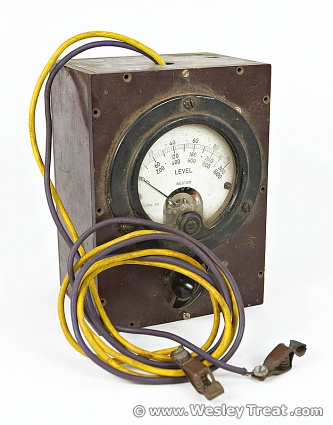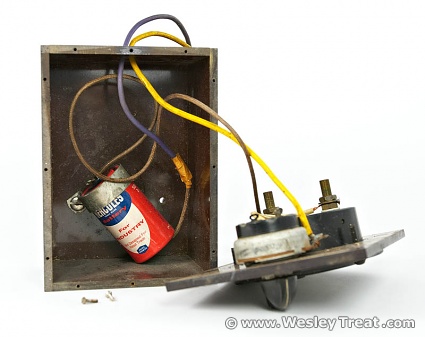God, I love buttons. Buttons, switches, knobs and flashy lights. They don't even have to do anything. Just depress, click, turn and flash. I'm actually a bit of a philistine when it comes to all these new touch-screens and LCD displays. Well OK, I love those too, but there is something intrinsically satisfying about flicking a nice, aluminum toggle and hearing a metallic snap that tapping a bit of plastic can never bring.
As such, I've recently decided to start looking out for examples of such technology — gadgets from an era when clicking and flicking were just the way things got done. I don't care much what purpose said gadgets originally served, as long as they have manual interfaces and look cool.
My quest officially commenced two weekends ago. On a trip out to Graham, Texas, to visit a couple of friends who manage a wonderful, old-fashioned drive-in movie theater, I spotted a gigantic snowman looking very much like the one voiced by Burl Ives in those old claymation films. He was standing amid a bunch of dusty old junk in front of a quiet shop with a sign that read, "THIS IS NOT A MUSEUM. Everything in here is for sale!"
With my gadget radar going off, I spent two blocks convincing the two friends driving with me to turn around and have a look. (Actually, the first block was spent making dirty claymation jokes, but that's really irrelevant.)
Inside was a musty wonderland of old cash registers, bee smokers, 1960s Popular Mechanics magazines and other misfit attic fill. Unfortunately, there were no decent antique cameras (ongoing collection no. 1) or tiki accouterments (collection no. 2), but buried among some antique taillights and a few old electrical parts, I discovered a gold-colored box mysteriously labeled "Trail-a-Matic." It was beautiful!
Anything with the suffix "-a-matic" is an instant winner in my book, but this little anodized gadget had something extra special: one of everything. There was a big, black knob, a metal toggle switch, a green indicator light and a little, red button. I had no idea what any of them were for, but I couldn't keep my hands off.
OK, so it was actually missing one thing I've neglected to list so far: an indicator dial. Before LEDs, or even nixie tubes, electronics had little needles that danced back and forth to tell you what was up. Or down. But this little oversight was quickly remedied as I spotted a terrific, brown Bakelite box on the next shelf. Again, I had no idea what it did, but the screw-studded bezel and the old-fashioned knob charmed me like a puppy with a snaggle-tooth.
When I arrived home with the first inductees into collection no. 3, I started doing a little research to find out what they were for. The brown box was easy, since it told me right on the side: VHF LOOP ANTENNA METER.
I removed the one screw still holding the front panel in place (all but the minimum necessary to keep the whole thing from falling apart had been removed) and found an old battery inside. The rest looked like it had been cannibalized. A "sensitivity control" was missing from the side and the "meter multiplier (1x, 3x, 10x)" was absent from the top, the hole for which now had two wires coming out, each ending in a mini alligator clip. Plus, the knob on the front appeared to be a replacement, as it doesn't easily clear the dial's bezel.
If I had to guess, I'd say the gadget in question had been repurposed. Where it once measured the strength of an antenna's signal, it now tests something known only to the mad gizmo butcher who gutted it. But, no matter. It still met my two requirements: manual interface, look cool.
As for the magical Trail-a-Matic, some patent searching revealed that it was a control box originating in the latter part of the '60s that implemented mercury switches and braking controls to automatically stabilize the swaying tendencies of automotive trailers. In short, it kept campers and such from swerving behind one's car. In fact, it wouldn't be too much of a stretch to imagine this little beauty mounted to the trailer hitch of a shiny Airstream rolling smoothly down some back road. All the grime on the front is probably pavement smegma, the by-product of adventure. I couldn't have been more pleased.
I wonder what magical gizmos await me in the future.







2 Comments
was searching for the wiring schematic for the model-R20A1. I need it becouse this is the device my dad had in his 1981 gmc 1 ton dually for towing trailers. your only showing half of the device, there are two parts. this is the equalizer and the other is the aplicator (which is ran off of direct brake fluid pressure with a line connecting directly to the master cylinder.)along with the equalizer it converts the fluid pressure to adjustable electrical power to the trailer brakes. This is top of the line stuff in the early 80's. now a days they have a little compact solid state box about a third of the size of the equalizer that does it all for the trailer brakes. I am trying to keep my dads truck as original as possible this is why i would like to keep this old style braking equipment. if you find a schematic please let me know. (add the comment and i will be checking)
I was poking around online & came across your post. My dad invented & sold the ASCS (Automatic Stablization Control System) to Holiday Rambler from 1972 until the 80's sometime. Are you still in need of more info on it? My email is Zipperlee@gmail.com